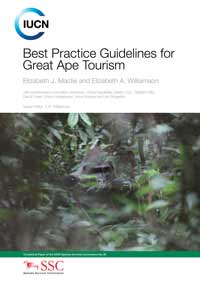 Best Practice Guidelines for Great Ape Tourism
Best Practice Guidelines for Great Ape Tourism
Tourism is often proposed as a strategy to fund conservation efforts to protect great apes and their habitats, or as a way for local communities to participate in, and benefit from, conservation activities on behalf of great apes. A few very successful sites point to the considerable potential of conservation-based great ape tourism, but it will not be possible to replicate this success everywhere. The number of significant risks to great apes that can arise from tourism require a cautious approach. If great ape tourism is not based on sound conservation principles right from the start, the odds are that economic objectives will take precedence, the consequences of which in all likelihood would be damaging to the well-being and eventual survival of the apes, and detrimental to the continued preservation of their habitat.
These guidelines have been developed for both existing and potential great ape tourism sites that wish to improve the degree to which their programme contributes to the conservation rather than the exploitation of great apes. The authors summarise lessons learned during three decades of great ape tourism and associated impact studies. They then present guiding principles and specific guidelines that are based on experience and impact studies.
Citation: Macfie, E.J. & Williamson, E.A. (2010). Best Practice Guidelines for Great Ape Tourism. IUCN SSC Primate Specialist Group, Gland, Switzerland.
PDFs of these guidelines are available in three languages:
English: Best Practice Guidelines for Great Ape Tourism
Elizabeth J. Macfie and Elizabeth A. Williamson with contributions from Marc Ancrenaz, Chloe Cipolletta, Debby Cox, Christina Ellis, David Greer, Chloe Hodgkinson, Anne Russon and Ian Singleton
Français: Lignes directrices pour de meilleures pratiques en matière de tourisme de vision des grands singes
Elizabeth J. Macfie et Elizabeth A. Williamson avec la contribution de Marc Ancrenaz, Chloé Cipolletta, Debby Cox, Christina Ellis, David Greer, Chloe Hodgkins, Anne Russon et Ian Singleton
Bahasa Indonesia: Panduan Wisata Kera Besar
Elizabeth J. Macfie dan Elizabeth A. Williamson dengan kontribusi dari Marc Ancrenaz, Chloe Cipolletta, Debby Cox, Christina Ellis, David Greer, Chloe Hodgkins, Anne Russon dan Ian Singleton
To request a paper copy of these guidelines, please contact Jill Lucena at jlucena@rewild.org
To access SARS-COV-2 & COVID-19 advisories, please click here
Please also visit the Protect Great Apes From Disease website to download posters and a booklet designed to sensitize tourists to disease transmission risks and COVID-19 prevention measures. Guide training modules are in development:
https://www.protectgreatapesfromdisease.com/
And take the Gorilla Friendly Pledge!
Tourism feasibility study report: Macfie, E.J. (2007). Studying the potential of gorilla-based tourism as a possible tool for the long-term conservation and management of the Afi Mountain Wildlife Sanctuary Cross River Gorilla population, Cross River State, Nigeria. Report to Afi Mountain Wildlife Sanctuary Partnership, Nigeria. PDF download
The Primate Specialist Group gratefully acknowledges financial support from the Arcus Foundation and the U.S. Fish & Wildlife Service for the production and publication of the IUCN guidelines.




